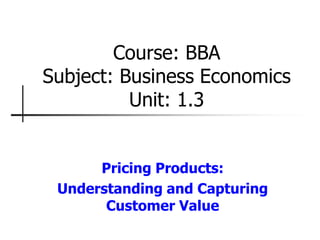
Bba 1 be 1 u-1.3 prise and values
- 1. Pricing Products: Understanding and Capturing Customer Value Course: BBA Subject: Business Economics Unit: 1.3
- 2. Chapter Outline 1. What Is Price? 2. Factors to Consider When Setting Prices 10-3
- 3. What Is Price? Price is the amount of money charged for a product or service. It is the sum of all the values that consumers give up in order to gain the benefits of having or using a product or service. Price is the only element in the marketing mix that produces revenue; all other elements represent costs 10-4
- 4. Factors to Consider When Setting Prices Effective customer-oriented pricing involves understanding how much value consumers place on the benefits they receive from the product and setting a price that captures that value 10-5 Customer Perception of Value
- 5. Factors to Consider When Setting Prices Customer Perception of Value Value-based pricing uses the buyers’ perceptions of value, not the seller’s cost, as the key to pricing. Price is considered before the marketing program is set. • Value-based pricing is customer driven • Cost-based pricing is product driven 10-6
- 6. Factors to Consider When Setting Prices Customer Perception of Value Value-based pricing • Good-value pricing • Value-added pricing 10-7
- 7. Factors to Consider When Setting Prices Customer Perception of Value Good-value pricing offers the right combination of quality and good service to fair price Existing brands are being redesigned to offer more quality for a given price or the same quality for less price 10-8
- 8. Factors to Consider When Setting Prices Customer Perception of Value Value-added pricing attaches value-added features and services to differentiate offers, support higher prices, and build pricing power Pricing power is the ability to escape price competition and to justify higher prices and margins without losing market share 10-10
- 9. Factors to Consider When Setting Prices Company and Product Costs Cost-based pricing involves setting prices based on the costs for producing, distributing, and selling the product plus a fair rate of return for its effort and risk 10-11
- 10. Factors to Consider When Setting Prices Company and Product Costs Types of costs • Fixed costs • Variable costs • Total costs 10-12
- 11. Factors to Consider When Setting Prices Company and Product Costs Fixed costs are the costs that do not vary with production or sales level • Rent • Heat • Interest • Executive salaries 10-13
- 12. Factors to Consider When Setting Prices Company and Product Costs Variable costs are the costs that vary with the level of production • Packaging • Raw materials 10-14
- 13. Factors to Consider When Setting Prices Company and Product Costs Total costs are the sum of the fixed and variable costs for any given level of production 10-15
- 14. Factors to Consider When Setting Prices Break-Even Analysis Break-even pricing is the price at which total costs are equal to total revenue and there is no profit 10-19
- 15. Factors to Consider When Setting Prices break-even= fixed cost volume (price-variable cost) 10-20 Break-Even Analysis
- 16. Source: Manquee book managerial economics. www.Slideshare.com www.Wikipedia.com www.Google.com
